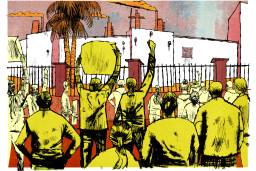
Social Security, the New Deal program that has provided a basic level of economic support for the nation’s elderly, disabled and orphaned for 70 years, is in grave danger — not from Baby Boomers’ rising demands, but from a campaign of lies and fear-mongering, led by the president.
The truth? There is no Social Security crisis. None whatsoever.
Yet, in his State of the Union address, President Bush put the campaign to destroy Social Security — and its promise of security for the aged and disabled — front and center, claiming that the system founded in 1935 is headed for bankruptcy in 2042.
Like the mythical weapons of mass destruction in Iraq, this was a flat-out lie. First of all, even if the date were correct, all that would happen in 2042 would be that the trust fund used to pay out benefits to workers would be exhausted. Even then, current workers’ taxes would continue to cover 73 percent of promised benefits to retirees.
More importantly, that 2042 projection by the increasingly politicized Social Security Administration was a conservative projection made a few years ago based upon unreasonably low estimates of future economic growth. It has already been pushed back by several years of good economic performance. In fact, the Congressional Budget Office and most independent economists say that the trust fund should enable the system to cover all benefits through at least 2052 and perhaps through 2080 and beyond. And here’s something the president has not told people: If the cap on income subject to Social Security taxation — currently set at $90,000 in wages — was eliminated so that all income was subject to the tax, there would be no shortfall in the trust fund — not in 2042, not in 2075, never.
But the most crucial fact that the president and right-wing critics of Social Security have failed to mention is that, by 2045, nearly all of the Baby Boom generation will have already shuffled off this mortal coil, taking their outsized claims for benefits with them.
Retirement policies
Given that there is no crisis, why are the president, right-wing politicians and pundits, corporate leaders, business organizations — and the media — all calling for “reforms” to “save” the system? They understand that the Baby Boom generation, as it approaches retirement, poses a crisis — not for Social Security, but for their political agenda. They know that if they can effectively kill off the program before it becomes a core Boomer issue, it will be much harder to reestablish it.
Consider this: Just as there will be nearly twice as many elderly retirees collecting benefits when the wave of Americans born between 1945 and 1960 hits its retirement age peak (the first Boomers start retiring in 2011), there will also be twice as many elderly voters. While today’s seniors came of age listening to Perry Como in the politically quiescent ’50s, tomorrow’s retirees will be people who listened to Bob Dylan and cut their political teeth on the civil rights and antiwar movements of the ’60s and ’70s.
In a few years, we can expect to see an unprecedentedly large senior lobby that knows how to organize, and how to take it to the streets and fight hard when its own interests are at stake. Once they near retirement, this powerful voting bloc will see Social Security and Medicare as their number one political issue. If Social Security is already the “third rail” of electoral politics, not to be touched, in a few years, it will become the Molotov cocktail, exploding the political status quo.
Corporate America knows this. The people in the boardrooms and the conservative think tanks aren’t worried about 2042. They don’t think that long-term. If they did, they wouldn’t be so cavalier about the destruction of the environment and about global warming. They’re worried about 2010 and the senior revolution that is around the corner.
Today, people over 65, as powerful an electoral bloc as they are, represent only 17 percent of the voting age population. By 2025, when the bulk of Baby Boomers will be in the 65 – 80 age bracket, retirees will represent 25 percent of the voting-age population, an increase of 45 percent in their relative voting power. If those aged 55 to 64 are added into the equation — a reasonable assumption, since people who reach 55 are starting to think about their retirement and tend to vote more in line with the interests of actual retirees — the elderly and near-elderly will represent 40 percent of the electorate.
The right talks ominously of a generational conflict between older retirees collecting pensions and younger workers paying the taxes to cover them. This is a ruse — a reflection of a panicky effort to destroy Social Security before the Baby Boomers realize where their real political interests lie. Not everyone has children, but everyone has parents. How many people complain about the size of their parents’ Social Security checks? How many people want to have to be personally responsible for their elderly parents’ financial well-being? Even among young workers, a secure and generous retirement system has considerable support, because people don’t just vote their own interests; they vote their parents’ and grandparents’ interests too.
The right doesn’t have much time on this issue. Somewhere in their mid-50s, people start to think seriously about retirement. Today’s oldest Baby Boomers are just hitting that milestone now, and when they start to contemplate their retirement, the picture will not be pleasant. Property values — where many have placed their faith and their savings — are stagnating, not rising. Post-Enron, those 401(k) pensions that so excited the middle class a few years ago have been treading water. Meanwhile, companies are whittling away pension programs as fast as they can, eliminating “defined benefit” plans that pay benefits based upon set formulas and replacing them with plans that pay based upon what employees contributed, and on how well the investment portfolio performed. According to the American Benefits Council, between 1985 and 2002, the number of companies in the U.S. offering defined benefit plans fell from 114,396 to just 32,321.
Time is ticking
Given the sorry state of the private safety net, it won’t be long before a movement springs up among the new elderly and near elderly not just to “rescue” Social Security, but to radically transform it into a true retirement program. Tomorrow’s senior lobby won’t feel constrained by current law, which makes workers foot half the bill. (We’re talking about their own kids, after all!) We can expect to see a push for more of the tax burden to be shifted onto employers. We can also expect to see future Congresses pressured into passing legislation that will remove the income cap on the Social Security tax, as well as make private pensions fully portable, so that employers can’t pocket years of contributions every time they let go workers before they are “vested.” A movement to expand Medicare from a niggardly program that only barely covers the medical care of the elderly to a full-fledged national healthcare program that covers everyone may also be in the cards.
That is a scary vision for corporations and the right, and it’s why Bush is pushing to wreck the system now. The president’s proposed “solution” — private accounts for younger workers — would not fix Social Security, because, again, there is no “problem” to fix. But by removing some contributions from the reserve fund, they would create problems. The huge costs of financing the transition to private accounts and the new fees those accounts incur, combined with the risks associated with private investments, will jeopardize benefits for current retirees and for younger workers. Separate retirement plans will also pit the young against the old, making it politically easier for a future Congress to continue slashing the remnants of Social Security.
It’s time to see the president’s attack for what it is: an attempt to destroy the most enduring legacy of the New Deal.

I hope you found this article important. Before you leave, I want to ask you to consider supporting our work with a donation. In These Times needs readers like you to help sustain our mission. We don’t depend on—or want—corporate advertising or deep-pocketed billionaires to fund our journalism. We’re supported by you, the reader, so we can focus on covering the issues that matter most to the progressive movement without fear or compromise.
Our work isn’t hidden behind a paywall because of people like you who support our journalism. We want to keep it that way. If you value the work we do and the movements we cover, please consider donating to In These Times.







